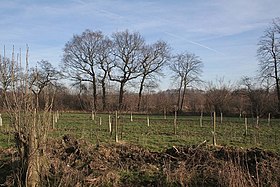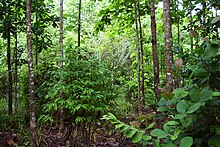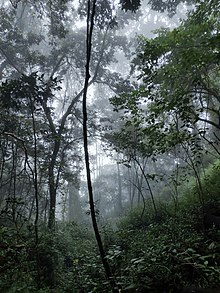User:CarbonBotany/sandbox
Forestation is either growing existing forests (proforestation)[1] or establishing forest growth on areas that either had forest or lacked it naturally.[2] In the first case, the process is called reforestation,[3] or reafforestation while the second is called afforestation.[4] Change in land use and natural disturbance can influence tree cover and complicate the distinction between different forms of forestation.
Massive afforestation has been proposed as a method to mitigate climate change, though its effectiveness in some regions is limited by the albedo effect.[5]
Afforestation
[edit]
Afforestation is the establishment of a forest or stand of trees in an area where there was no recent tree cover.[6] There are three types of afforestation: Natural regeneration, agroforestry and tree plantations.[7] Afforestation has many benefits. In the context of climate change, afforestation can be helpful for climate change mitigation through the route of carbon sequestration. Afforestation can also improve the local climate through increased rainfall and by being a barrier against high winds. The additional trees can also prevent or reduce topsoil erosion (from water and wind), floods and landslides. Finally, additional trees can be a habitat for wildlife, and provide employment and wood products.[7]
In comparison, reforestation means re-establishing forest that have either been cut down or lost due to natural causes, such as fire, storm, etc. Nowadays, the boundaries between afforestation and reforestation projects can be blurred as it may not be so clear what was there before, at what point in time.
An essential aspect of successful afforestation efforts lies in the careful selection of tree species that are well-suited to the local climate and soil conditions. By choosing appropriate species, afforested areas can better withstand the impacts of climate change.[8]
Earth offers enough room to plant an additional 0.9 billion ha of tree canopy cover.[9] Planting and protecting them would sequester 205 billion tons of carbon[9] which is about 20 years of current global carbon emissions.[10] This level of sequestration would represent about 25% of the atmosphere's current carbon pool.[9]
Australia, Canada, China, India, Israel, United States and Europe have afforestation programs to increase carbon dioxide removal in forests and in some cases to reduce desertification. However, afforestation of grasslands and savanna areas can create problems of their own.[11] Carbon sequestration estimates in those areas often do not include the full amount of carbon reductions in soils and slowing tree growth over time. Also, afforestation can negatively affect biodiversity through increasing fragmentation and edge effects for the habitat remaining outside the planted area.
Reforestation
[edit]
Reforestation is the practice of restoring previously existing forests and woodlands that have been destroyed or damaged. The prior forest destruction might have happened through deforestation, clearcutting or wildfires. Three important purposes of reforestation programs are for harvesting of wood, for climate change mitigation, and for ecosystem and habitat restoration purposes. One method of reforestation is to establish tree plantations, also called plantation forests. They cover about 131 million ha worldwide, which is 3% of the global forest area and 45% of the total area of planted forests.[12]
Globally, planted forests increased from 4.1% to 7.0% of the total forest area between 1990 and 2015.[13] Plantation forests made up 280 million ha (hectare) in 2015, an increase of about 40 million ha in the previous ten years.[14] Of the planted forests worldwide, 18% of that area consists of exotic or introduced species while the rest consist of species native to the country where they are planted.[15]
There are limitations and challenges with reforestation projects, especially if they are in the form of tree plantations. Firstly, there can be competition with other land uses and displacement risk. Secondly, tree plantations are often monocultures which comes with a set of disadvantages, for example biodiversity loss. Lastly, there is also the problem that stored carbon is released at some point.
The effects of reforestation will be farther in the future than those of proforestation (the conservation of intact forests).[16] Instead of planting entirely new areas, it might be better to reconnect forested areas and restore the edges of forest. This protects their mature core and makes them more resilient and longer-lasting.[17] It takes much longer − several decades − for the carbon sequestration benefits of reforestation to become similar to those from mature trees in tropical forests. Therefore, reducing deforestation is usually more beneficial for climate change mitigation than is reforestation.[18]
Many countries carry out reforestation programs. For example, in China, the Three Northern Protected Forest Development Program – informally known as the "Great Green Wall" – was launched in 1978 and scheduled to last until 2050. It aims to eventually plant nearly 90 million acres of new forest in a 2,800-mile stretch of northern China.[19] Such programs often blur the boundaries between reforestation and afforestation (the latter being the establishment of a forest in an area where there was no forest before).
Proforestation
[edit]
Forest management is a branch of forestry concerned with overall administrative, legal, economic, and social aspects, as well as scientific and technical aspects, such as silviculture, forest protection, and forest regulation. This includes management for timber, aesthetics, recreation, urban values, water, wildlife, inland and nearshore fisheries, wood products, plant genetic resources, and other forest resource values.[20] Management objectives can be for conservation, utilisation, or a mixture of the two. Techniques include timber extraction, planting and replanting of different species, building and maintenance of roads and pathways through forests, and preventing fire.
Many tools like remote sensing, GIS and photogrammetry[21][22] modelling have been developed to improve forest inventory and management planning.[23] Scientific research plays a crucial role in helping forest management. For example, climate modeling,[24][25][26] biodiversity research,[27][28] carbon sequestration research,[25][24][29] GIS applications,[27][30] and long-term monitoring[26][28] help assess and improve forest management, ensuring its effectiveness and success.
References
[edit]- ^ Moomaw, William R.; Masino, Susan A.; Faison, Edward K. (2019). "Intact Forests in the United States: Proforestation Mitigates Climate Change and Serves the Greatest Good". Frontiers in Forests and Global Change (in Urdu). 2. doi:10.3389/ffgc.2019.00027. ISSN 2624-893X.
- ^ Nyland, R.D. Silviculture: Concepts and Applications. 3rd ed. 2016. p. 67. link.
- ^ "SAFnet Dictionary | Definition For [reforestation]". Dictionaryofforestry.org. 2008-08-13. Archived from the original on 2012-03-14. Retrieved 2012-02-17.
- ^ "SAFnet Dictionary | Definition For [afforestation]". Dictionaryofforestry.org. 2008-10-23. Archived from the original on 2012-03-14. Retrieved 2012-02-17.
- ^ Rohatyn, Shani; Yakir, Dan; Rotenberg, Eyal; Carmel, Yohay (2022-09-23). "Limited climate change mitigation potential through forestation of the vast dryland regions". Science. 377 (6613): 1436–1439. doi:10.1126/science.abm9684. ISSN 0036-8075. PMID 36137038.
- ^ Terms and definitions – FRA 2020 (PDF). Rome: FAO. 2018. Archived (PDF) from the original on 2019-08-09.
- ^ a b Lark, Rachel (2023-10-02). "The Importance of Afforestation". Environment Co. Archived from the original on 4 January 2024. Retrieved 2024-01-04.
- ^ Windisch, Michael G.; Davin, Edouard L.; Seneviratne, Sonia I. (October 2021). "Prioritizing forestation based on biogeochemical and local biogeophysical impacts". Nature Climate Change. 11 (10): 867–871. Bibcode:2021NatCC..11..867W. doi:10.1038/s41558-021-01161-z. S2CID 237947801. ProQuest 2578272675.
- ^ a b c Bastin, Jean-Francois; Finegold, Yelena; Garcia, Claude; Mollicone, Danilo; Rezende, Marcelo; Routh, Devin; Zohner, Constantin M.; Crowther, Thomas W. (2019-07-05). "The global tree restoration potential". Science. 365 (6448): 76–79. Bibcode:2019Sci...365...76B. doi:10.1126/science.aax0848. ISSN 0036-8075. PMID 31273120. Archived from the original on 3 January 2020. Retrieved 4 January 2024.
- ^ Tutton, Mark (2019-07-04). "Restoring forests could capture two-thirds of the carbon humans have added to the atmosphere". CNN. Archived from the original on 23 March 2020. Retrieved 2024-07-15.
- ^ Dasgupta, Shreya (2021-06-01). "Many Tree-Planting Campaigns Are Based on Flawed Science". The Wire Science. Archived from the original on 12 June 2021. Retrieved 2021-06-12.
- ^ "Global Forest Resource Assessment 2020". www.fao.org. Retrieved 20 September 2020.
- ^ Payn, Tim; Carnus, Jean-Michel; Freer-Smith, Peter; Kimberley, Mark; Kollert, Walter; Liu, Shirong; Orazio, Christophe; Rodriguez, Luiz; Silva, Luis Neves; Wingfield, Michael J. (2015). "Changes in planted forests and future global implications". Forest Ecology and Management. 352: 57–67. doi:10.1016/j.foreco.2015.06.021. ISSN 0378-1127.
- ^ FAO, ed. (2016). Global forest resources assessment 2015: how are the world’s forests changing?. Rome: Food and Agriculture Organization of the United Nations. ISBN 978-92-5-109283-5.
{{cite book}}: CS1 maint: date and year (link) - ^ Ennos, Richard; Cottrell, Joan; Hall, Jeanette; O'Brien, David (2019). "Is the introduction of novel exotic forest tree species a rational response to rapid environmental change? – A British perspective". Forest Ecology and Management. 432: 718–728. doi:10.1016/j.foreco.2018.10.018. hdl:20.500.11820/725af6fe-4ef8-4345-8f06-634eb59414ff. ISSN 0378-1127.
- ^ "Why Keeping Mature Forests Intact Is Key to the Climate Fight". Yale E360. Retrieved 28 September 2020.
- ^ Mackey, Brendan; Dooley, Kate (6 August 2019). "Want to beat climate change? Protect our natural forests". The Conversation. Retrieved 28 September 2020.
- ^ Bank, European Investment (2022-12-08). Forests at the heart of sustainable development: Investing in forests to meet biodiversity and climate goals. European Investment Bank. ISBN 978-92-861-5403-4.
- ^ Harrell, Stevan (2023). An Ecological History of Modern China. Seattle: University of Washington Press. ISBN 9780295751719.
- ^ "Glossary of Forestry Terms in British Columbia" (PDF). Ministry of Forests and Range (Canada). March 2008. Retrieved 2009-04-06.
- ^ I. Balenovich, A. Seletkovich, et al. Comparison of Classical Terrestrial and Photogrammetric Method in Creating Management Division. FORMEC. Croatia 2012. pp. 1-13.
- ^ I. Balenović, D. Vuletić, et al. Digital Photogrammetry – State of the Art and Potential for Application in Forest Management in Croatia. SEEFOR. South-East European Forestry. #2, 2011. pp. 81–93.
- ^ Mozgeris, G. (2008) “The continuous field view of representing forest geographically: from cartographic representation towards improved management planning”. S.A.P.I.EN.S. 1 (2)
- ^ a b Anderegg, William R. L.; Wu, Chao; Acil, Nezha; Carvalhais, Nuno; Pugh, Thomas A. M.; Sadler, Jon P.; Seidl, Rupert (2 September 2022). "A climate risk analysis of Earth's forests in the 21st century" (PDF). Science. 377 (6610): 1099–1103. Bibcode:2022Sci...377.1099A. doi:10.1126/science.abp9723. PMID 36048937. S2CID 252010508.
- ^ a b Windisch, Michael G.; Davin, Edouard L.; Seneviratne, Sonia I. (October 2021). "Prioritizing forestation based on biogeochemical and local biogeophysical impacts". Nature Climate Change. 11 (10): 867–871. Bibcode:2021NatCC..11..867W. doi:10.1038/s41558-021-01161-z. S2CID 237947801. ProQuest 2578272675.
- ^ a b Benedek, Zsófia; Fertő, Imre (2013). "Development and application of a new Forestation Index: global forestation patterns and drivers" (Document). IEHAS Discussion Papers. hdl:10419/108304. ProQuest 1698449297.
- ^ a b Zhang, Mingfang; Wei, Xiaohua (5 March 2021). "Deforestation, forestation, and water supply". Science. 371 (6533): 990–991. Bibcode:2021Sci...371..990Z. doi:10.1126/science.abe7821. PMID 33674479. S2CID 232124649.
- ^ a b Prevedello, Jayme A.; Winck, Gisele R.; Weber, Marcelo M.; Nichols, Elizabeth; Sinervo, Barry (20 March 2019). "Impacts of forestation and deforestation on local temperature across the globe". PLOS ONE. 14 (3): e0213368. Bibcode:2019PLoSO..1413368P. doi:10.1371/journal.pone.0213368. PMC 6426338. PMID 30893352. Gale A579457448.
- ^ Portmann, Raphael; Beyerle, Urs; Davin, Edouard; Fischer, Erich M.; De Hertog, Steven; Schemm, Sebastian (4 October 2022). "Global forestation and deforestation affect remote climate via adjusted atmosphere and ocean circulation". Nature Communications. 13 (1): 5569. Bibcode:2022NatCo..13.5569P. doi:10.1038/s41467-022-33279-9. PMC 9532392. PMID 36195588.
- ^ AbdulBaqi, Faten Khalid (June 2022). "The effect of afforestation and green roofs techniques on thermal reduction in Duhok city". Trees, Forests and People. 8: 100267. Bibcode:2022TFP.....800267A. doi:10.1016/j.tfp.2022.100267. S2CID 248646593.
Alternative landcovers
Urban
Grassland
Other
Objectives[edit]
[edit]Climate
Carbon
Hydrology
Biodiversity
